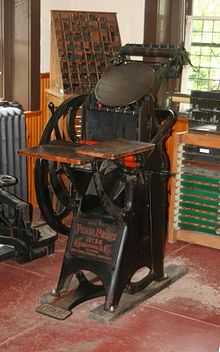Roycroft
|
Roycroft Campus | |
 | |
|
The Copper Shop, first building of the Roycroft Campus to be restored | |
| Location | Main and South Grove St., East Aurora, NY |
|---|---|
| Nearest city | Buffalo |
| Coordinates | 42°46′04″N 78°37′04″W / 42.76778°N 78.61778°WCoordinates: 42°46′04″N 78°37′04″W / 42.76778°N 78.61778°W |
| Built | 1895 |
| Governing body | Roycroft Organization |
| NRHP Reference # | 74001236 |
| Significant dates | |
| Added to NRHP | November 8, 1974[1] |
| Designated NHL | February 26, 1986[2] |
Roycroft was a reformist community of craft workers and artists which formed part of the Arts and Crafts movement in the United States. Elbert Hubbard founded the community in 1895 in the village of East Aurora, Erie County, New York, near Buffalo. Participants were known as Roycrofters. The work and philosophy of the group, often referred to as the Roycroft movement, had a strong influence on the development of American architecture and design in the early 20th century.
History

The name "Roycroft" was chosen after the printers, Samuel and Thomas Roycroft, who made books in London from about 1650–1690. And beyond this, the word roycroft had a special significance to Elbert Hubbard, meaning King's Craft. In guilds of early modern Europe, king's craftsmen were guild members who had achieved a high degree of skill and therefore made things for the King. The Roycroft insignia was borrowed from the monk Cassiodorus, a 13th-century bookbinder and illuminator.
Elbert Hubbard had been influenced by the ideas of William Morris on a visit to England. He was unable to find a publisher for his book Little Journeys, so inspired by Morris's Kelmscott Press, decided to set up his own private press to print the book himself, founding Roycroft Press.
His championing of the Arts and Crafts approach attracted a number of visiting craftspeople to East Aurora, and they formed a community of printers, furniture makers, metalsmiths, leathersmiths, and bookbinders. A quotation from John Ruskin formed the Roycroft "creed":
A belief in working with the head, hand and heart and mixing enough play with the work so that every task is pleasurable and makes for health and happiness.
The inspirational leadership of Hubbard attracted a group of almost 500 people by 1910, and millions more knew of him through his essay A Message to Garcia.
In 1915 Hubbard and his wife, noted suffragist Alice Moore Hubbard, died in the sinking of RMS Lusitania, and the Roycroft community went into a gradual decline. Following Elbert's death, his son Bert took over the business. In attempts to keep his father's business afloat, Bert proposed selling Roycroft’s furniture through major retailers. Sears & Roebuck eventually agreed to carry the furniture, but this was only a short lived success.[3]
Fourteen original Roycroft buildings are located in the area of South Grove and Main Street in East Aurora. Known as the "Roycroft Campus", this rare survival of an art colony was awarded National Historic Landmark status in 1986.[2][4][5]
The Elbert Hubbard Roycroft Museum, housed in the George and Gladys Scheidemantel House, in East Aurora is the main collection and research centre for the work of the Roycrofters.
Gallery
-
Front of the Town Hall building
-
Roycroft Inn & Restaurant
-
Side of the Town Hall building
-
Roycroft Inn sign
-

Crest of the Roycroft
-

Roycroft Campus welcome sign
-
Sign about Elbert Hubbard
-

Sign with Roycroft crest and lettering
Famous Roycrofters
William Wallace Denslow (W.W.Denslow) illustrated the first OZ book (The Wonderful Wizard of Oz) and had a distinctive Roycroft inspired "logo."
William Joseph "Dard" Hunter was an American authority on making paper by hand, as well as printing using handmade type. He published a number of books on traditional, pre-industrial, techniques for making paper.
See also
- American craft
- Arden, Delaware
- Frank Lloyd Wright
- Gustav Stickley
- Rose Valley, Pennsylvania
- Roy Croft
References
- ↑ "National Register Information System". National Register of Historic Places. National Park Service. 2007-01-23.
- ↑ 2.0 2.1 "Roycroft Campus". National Historic Landmark summary listing. National Park Service. 2007-09-18.
- ↑ "Elbert Hubbard - The Man." September 28, 2010.
- ↑ ""Roycroft Campus", July 1985, by Carolyn Pitts (National Register of Historic Places Inventory-Nomination)" (pdf). National Park Service. 1985-07. Check date values in:
|date=(help) - ↑ "Roycroft Campus--Accompanying 3 photos, exterior, from 1973. (National Register of Historic Places Inventory-Nomination)" (pdf). National Park Service. 1985-07. Check date values in:
|date=(help)
Further reading
- Champney, Freeman (1968) Art & glory; the story of Elbert Hubbard Crown Publishers, New York, OCLC 274494
- Hamilton, Charles Franklin (1973) As Bees in Honey Drown: Elbert Hubbard and the Roycrofters A.S. Barnes, South Brunswick, ISBN 0-498-01052-X
- Cathers, David M. (1981) Furniture of the American Arts and Crafts Movement: Stickley and Roycroft Mission Oak New American Library, New York, ISBN 0-453-00397-4
- Via, Marie and Searl, Marjorie (eds.) (1994) Head, Heart, and Hand: Elbert Hubbard and the Roycrofters University of Rochester Press, Rochester, N.Y., ISBN 1-878822-43-8
- Turgeon, Kitty and Rust, Robert (1998) The Arts and Crafts Home Friedman/Fairfax Publishers, New York, ISBN 1-56799-455-5
- Rust, Robert et al. (2000) The Roycroft Campus (Images of America series) Arcadia Publishing, Charleston, SC, ISBN 0-7524-1344-9
External links
| Wikimedia Commons has media related to Roycroft. |
- Roycroft Organization
- Roycroft Inn, East Aurora
- Roycroft shop marks and related historical furniture maker details
- The Roycroft Community 1894-1938 by Hilary Davis
- The Arts & Crafts Movement: People: Elbert Hubbard
- The Roycroft Campus
- Roycrofters At Large Association
- The Winterthur Library Overview of an archival collection on the Roycrofters
- Roycrofters Collection: Books published at the Roycrofter colony founded by Elbert Hubbard, (97 items). From the Rare Book and Special Collections Division at the Library of Congress
| ||||||||||||||||||||||||||




